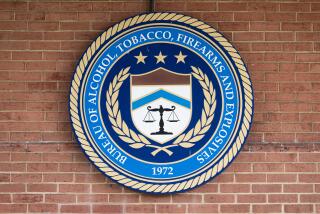‘Favorite’ at Bank Behind Scheme, Indictment Says
- Share via
When Don Kenneth Gray II dressed up as Santa Claus and handed out Christmas gifts at Valley State Bank in December, 1986, it was not the first time that he had pretended to be somebody else, according to the U.S. attorney’s office and the FBI.
For the last four months of 1986, Gray used the alias Daniel Ryan Hamilton and worked as a data processing clerk at the Encino bank. A quiet and hard-working employee, he was very popular. “Dan was our favorite employee,” said Diana Sherwood, his former supervisor and then head of the bank’s precious metals division. “There wasn’t a single employee who didn’t like Dan. He was even dating two girls in the department at the same time.”
But behind the facade, Gray was the mastermind of an elaborate attempt to steal $1.5 million worth of gold bars and coins from the tiny bank, according to a Feb. 19 indictment by a Los Angeles grand jury.
Gray, 29, was arrested Feb. 14 on charges of embezzlement and mail and wire fraud as he tried to re-enter the United States at San Ysidro, Calif. “He may have been coming back from Colombia, I’m not sure,” said Assistant U.S. Atty. Leon Weidman in Los Angeles. The FBI had been looking for Gray since January, 1987.
He is being held on $1-million bail at Metropolitan Corrections Center in San Diego and is scheduled to appear in federal court in San Diego this morning so prosecutors can have him transported to Los Angeles.
Blamed in Collapse
He refused to be interviewed for this story.
According to federal authorities, Gray and two others actually stole only $600,000 in gold. The rest of the plan was thwarted by an internal investigation at the bank.
But the gold has never been recovered, and bank officials have blamed the missing capital for Valley State’s collapse last September. Valley State has since been reopened as part of Capital Bank of California.
Also named in the indictment and still at large are Gray’s alleged accomplices, Andres Marin Salazar and Ignacio Marin Salazar, both of Colombia.
Gray himself has spent the past year living in Colombia, according to Assistant U.S. Atty. Patrick Coughlin in San Diego.
Gray landed his job at Valley State after reading a newspaper ad and attending a Saturday job fair held by the bank. He started work in the bank’s computer room on Sept. 17, 1986, and his duties, among other things, included entering buy and sell orders for the bank’s precious metals operation.
At the time, Gray and Andres Salazar were roommates in Woodland Hills, where they had installed home computers. “They used Valley State computers and their home computers as part of the scheme,” Weidman said. He refused to elaborate.
As part of the scheme, the indictment says, the three men established a phony corporation called Wilshire Investments in Flushing, N.Y., as a depository for the gold. The company appeared to be “a viable business, but in fact, its only function was to receive gold coins and bars embezzled from Valley State Bank,” the indictment reads.
Went Unnoticed
On or about Dec. 22, 1986, Gray allegedly entered an order into Valley State’s computer and onto its telex machine instructing Brinks, a Los Angeles precious metals depository, to ship 41 bars of gold worth $514,000 from Valley State’s account to Wilshire Investments in Flushing.
Later that day, Gray allegedly placed an order via computer for another depository, the Bank of Delaware, to deliver 2,000 of Valley State’s one-ounce Gold Eagle coins valued at $833,000 to the same Flushing address. Because it takes several days for such transactions to clear, the missing gold went unnoticed for almost a week.
Just two days later, Gray was celebrating the holiday season at the company’s Christmas party.
Then, during the morning on Dec. 29, 1986, Gray told Sherwood he needed to take an early lunch hour. “He told me he was going to lunch early because he was having problems with his car,” said Sherwood. “He never came back.”
Later that day, the Bank of Delaware started delivering Valley State’s gold coins to Wilshire Investments in Flushing, according to the indictment. Brinks already had delivered the gold bars three days earlier.
More to Read
Sign up for Essential California
The most important California stories and recommendations in your inbox every morning.
You may occasionally receive promotional content from the Los Angeles Times.










